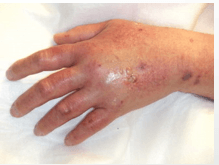Length of time to clean skin insertion site.
30 seconds
This is the body fluid located within the blood vessels is called this.
Intravascular

This complication is known as this.
infiltration
Your pt is complaining and saying the IV doesn't feel right, when you check it is red, warm, and tender at the IV insertion site. Name this.
Phlebitis
The nurse is removing peripheral IV and must observe this.
intactness of tip
You are about to teach your 9 y/o pt about IV insertion, what is the first step?
Figure out what they know
Lactated Ringer's is this type of fluid
isotonic
Your pt is getting intermittent IV fluids. You assess their vitals you notice your pt has wet lungs. This could be a sign of this.
fluid overload
You are assessing your pt's IV site and you notice it is cold and puffy at the insertion site. Tell us what this is called and give nursing intervention.
infiltrated, Stop IV fluid and start new IV.
This is the recommended frequency of hours a nurse should be assessing IV site.
at least every 4 hours or organizational policy
Number of inches to apply tourniquet above proposed insertion site.
4 to 6 inches
D5 0.45 NS is this type of fluid.
hypertonic
The nurse is attempting to flush pt's peripheral IV and is unable. The nurse should not do this.
force the flush
This is the frequency a continuous administration infusion set should be changed.
every 96 hours
The nurse notes bleeding around dressing at peripheral IV cath insertion site should do this.
assess the insertion site
Equipment/supplies used for peripheral IV insertion may contain substances, which is why the nurse will assess this.
allergies, especially to iodine, adhesive, or latex
Water moves into the cells, causing them to swell with this type of IV fluid.
hypotonic
The nurse just inserted a peripheral IV and has attached the NS flush to check patency. The nurse observe swelling at insertion site while flushing with NS. The swelling is indicative of this.
is infiltration
Nurse enters pt room and sees that IV is occluded and stops IV fluid. Name the next step.
determine the cause
Name 3 physical assessment findings that may be affected by the administration of IV solutions that the nurse should assess.
body weight, vitals, lung sounds, neck veins, cap refill, dependent edema, oral mucous membrane, LOC, urine output, IV site
Recommended length of time you are allowed to leave a tourniquet on
no longer than 1 min
Isotonic solutions are used to increase this body fluid volume.
extracellular fluid volume (which consists of intravascular and interstitial fluid)
Your patient is complaining of tingling and pins and needles sensation after insertion of peripheral IV. The nurse should consider what has happened.
a potential injury to the nerve
Nursing intervention if your pt is experiencing circulatory overload.
slow IV infusion, elevate HOB and call doc
Name 3 areas nurse should not select for peripheral IV site. (there are multiple)
pain on palpation
compromised areas
site distal to previous venipuncture site
hardened veins
fragile dorsal hand veins in older adults
upper extremity on side of breast surgery with axillary node dissection or lymphedema or after radiation, AV fistulas, affected extremity of CVA